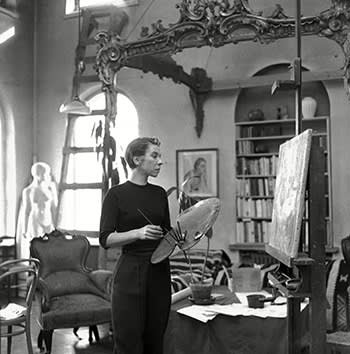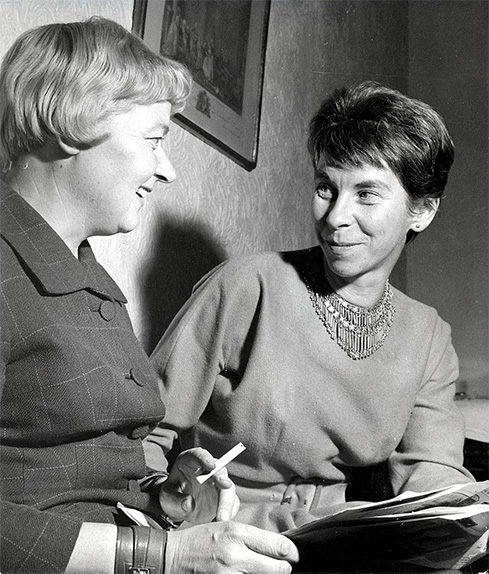The Veil of Isis #4
Tove Jansson
The Dr. Alisia Grace Chase (Professor of Art History at the State University of New York) has produced a valuable text entitled: Tove Jansson: "Live in peace; plant potatoes and dream." (Helsinki, 09-08-1914 - 27-06-2001), invites reflection in this second volume of Mumin: The Complete Collection of Mumin Comics. Tove Jansson. It consists of four chapters (continuation of four previous chapters): 5. Mumin's winter adventures. 6. Mama Mumin's babysitter. 7. Mumin makes a house. Mumin starts a new life.
We are introduced to the four characters: 1. Mumin: unpredictable, capricious and susceptible like any teenager his age. He always marvels at small pleasures and is not afraid to venture where the less intrepid would never dare to do so. For MuminThe word NO is the hardest word to pronounce, and for some time now he has been trying to be tougher. 2. Mama Mumin: his character is a rare combination of great intelligence and strong moral sense. With his noble and open background, he knows perfectly well how important it is to learn from mistakes, a principle that he always applies to the family. Without ever wanting to impose himself, inevitably, he always wins the battle, even though other people may find this way of thinking a little difficult to understand. 3. Miss Snork: The endearing and not at all vain girlfriend of Mumin usually indulges in her romantic dreams, even though, only when she allows him to, Mumin try to make her touch her feet to the ground. Miss Snork has no scruples about using her feminine charms, her sensual curves and her cunning to achieve her goals. Still, there are insecurities. 4. Papa Mumin: Papa Mumin's loyalty to his family is unquestionable, yet he can sometimes behave irresponsibly, even selfishly, especially when he gets carried away by dubious friendships and a good whiskey. Or simply when he feels like it. An incurable dreamer and storyteller, Papa Mumin likes to think of himself as a great adventurer.
In his semi-autobiographical book La hija del escultor (Bildhuggarens Dotter), Tove Jansson describes the environment in which she grew up as a child. And, in many ways, it resembles the environment inhabited by the fascinating characters of the Mumin comics: a magical, ramshackle house with a loving family, a large number of friends, and a variety of voracious guests, all set in the middle of a verdant valley just a stone's throw from the sea. After his birth, in August 1914, in Helsinki, the family began to spend their summers at home; first at the grandparents' extensive estate in the Stockholm archipelago, and later at the parents' small cottage near the town of Porvoo, in the Pellinge Islands in the Gulf of Finland. Perhaps the tender memories of that time are the most telling and evocative subject to spare. Whether it was collecting mother-of-pearl shells on the beach to decorate flower-bearers, rescuing buried treasures from the waves, or smearing river pebbles with margarine to make them even shinier, these ephemeral pleasures of nature, as well as the company of loved ones, provided Jansson with an early source of inspiration. Having liberal, artistic parents also helped to awaken Jansson's innate talent. Janssonand to foster her proverbial tolerance for any idiosyncratic manifestation. As the first-born daughter of a sculptor, Viktor Janssonand a graphic artist and illustrator, Signe Hammarsten-Jansson, Tove grew up in a most creative household that was often eccentric and boisterous. A family pet, a monkey named Poppolino - he reportedly loved to wear argyle sweaters - and a nanny who read Plato were just two conventional members of this extended Jansson family; and it is likely that these pecuiares, but beloved figures, became the models for the numerous dreamers, philosophers, and dilettantes who populate his fictional world. In the Valley of the Mumin, the peculiar views of each are equally respected.
These whimsically drawn creatures are comic in their humanity, and Jansson's predilection for bohemian life - very rich in emotion and feeling, though often poor in material resources - is probably reflected in the sensual frivolity of the Mumin. With the new adventures of the second volume of his comic strips, Tove Jansson shows us the goodness of living life our own way: questioning old traditions and creating new ones; rebelling against obsessive behaviors, such as Mr. Dynamic with sports and Ms. Fillyjonk with domestic cleaning. Characters such as the love-struck Mymlathe caterpillar nanny Mabel or the conciliatory Mama Mumin teach the importance of enjoying every moment and always looking for love, happiness and freedom: a maxim to which, they say, Jansson remained faithful for most of his life. At the age of fifteen, Tove Jansson published his first illustrations and cartoons in the Swedish-language Finnish satirical magazine with progressive ideas. Garmand shortly thereafter went to study at the university school of Konstfack Fine Arts of Stockholm. At the age of nineteen he continued with his studies at the drawing school of the Helsinki Art Societyto the National Gallery of Finland, as he traveled throughout the continent and exhibited his works both at home and abroad.
The year 1938, Jansson also studied in Paris, at the Adrien Holy School i a la Ecole des Beux ArtsAt that time she was already considered one of the most talented young Finnish artists. After a few stays abroad, and perhaps disappointed by the vanity and emptiness of modern art, she was already considered one of the most talented young Finnish artists, Tove Jansson settled in Finland for good. It was the pages of the magazine Garmin 1940, where Jansson introduced his character for the first time Muminand did so by turning him into something of an emblematic figure among his illustrations. In 1945, the rest of the members of the charming Mumin family disappeared in the first children's book he wrote. Tove Janson Småtrollen och den Stora Översvämningen (The little trola and the great flood). But it would be the third volume of the series, Trollkarlens Hatt (The Magician's Hat), the one that would achieve the greatest number of readers and would consecrate her forever as one of the most beloved authors among children. In the early 1950s, the Associated Pressin England, contacted Jansson to propose that he transform the adorable adventures of his magical Mumins into a comic book for adults. Considering that he had previously drawn a successful series of comic strips entitled Mumintrollet och jordanes underlång (The Mumin and the end of the world), for the Finnish Swedish-language newspaper Ny Tid, Jansson immediately accepted the proposal. In 1953, the London Evening News began publishing a daily strip of the Muminand soon these comics were appearing in more than forty newspapers around the world.
Jansson She drew the strips for five years, until she realized that this hectic daily rhythm, and the fact of being creative on demand, did not fit with her rather dilettante and capricious attitude towards life. An attitude that is reflected in the advice that Mybleone of the author's fictional alter egos, gives to those who tend to be anxious and distressed: "sit on a bridge and watch the water as it passes; or lurk in a swamp with your red wellington boots. Or stay at home, snugly huddled up, and listen to the hammering of the rain on the roof. It is very easy to amuse yourselves." In addition to writing ten children's novels, which have been translated into 34 languages, three books of illustrations on a variety of subjects, and the comic strips collected in these volumes, Jansson She was also passionately prolific with the other artistic activities she cultivated: she wrote several poetic, and often bittersweet, novels for adults, and she painted some nice and vivid murals for public institutions, such as the children's hospital. Aurora of Helsinki. Naturally, a life such as hers, devoted entirely to the cultivation of creativity and imagination, could not go unnoticed, and Jansson received numerous important awards for his work. Among them, the medal Nils Holgersson in 1953, the valuable gold medal from the Hans Christian Andersen Award 1966, the prize of the Swedish Academy 1972, the medal of Pro Finland 1976 and, in many cases, the Finnish State Literary Award. In 1995, six years before her death, the octogenarian Jansson was awarded the honorary title of professor of the Abo Akademi Universitya most fitting recognition for a vital woman who taught the world some of life's most fundamental lessons: float through the clouds, wear red boots and always, always, live in peace.
Background music during the program: Lars Gullin - Vintage 50's Swedish Jazz (1949-1961) (tracks 1 to 16).
Songs in order of appearance:
01. Don Byas – Cement Mixer -1947
02. James Moody Quintet - Straight -1949
03. Sahib Shihab - Conversations II -1964
04. Harry Arnold & Quincy Jones - Room 308


